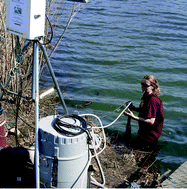Quantification of organic and microbial pollutant loading is expensive and labor-intensive because collection and analysis of grab samples are needed. Instruments are available, however, for in situ analysis of basic water quality parameters at high temporal resolution. Throughout the late summer and fall of 2008 a two-node water quality monitoring network was deployed to measure turbidity, specific conductance, pH, depth, temperature, dissolved oxygen, and nitrate at high frequencies in two urban streams in the Minneapolis, MN metropolitan area. Grab samples also were collected at 2 h intervals for 22 h during two dry periods and five rain events and analyzed for organic and microbial pollutants. This study investigated the viability of using in situ near real-time sensors to predict fecal coliforms, prometon (a residential herbicide), atrazine (an agricultural herbicide), and caffeine (a wastewater indicator) concentrations. Such pollutants can be used as indicators of sources that contribute to what is often termed “urban stream syndrome.” At one stream, linear correlations were observed between nitrate and caffeine (R2 = 0.66), turbidity and prometon (R2 = 0.91), and discharge and prometon (R2 = 0.92). At another location, caffeine linearly correlated with specific conductance (R2 = 0.64). A lack of correlation with sensed water quality parameters was also observed with some of the pollutants. When one considers that error is estimated to be as high as 200% when using monthly grab samples to estimate pollutant loading in streams, even moderate correlations, such as the ones found in this study, can provide better loading estimates if frequently sensed parameters can be used for load estimation. Therefore, such site-specific relationships can be used to estimate the loading of specific pollutants in near real-time until robust low-cost technologies to analyze these pollutants in situ become available.


 Please wait while we load your content...
Please wait while we load your content...